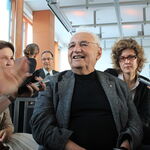Northern Light
Superstar
Also gonna put this out here if anyone on UT isn't working for the moment.........


Li Wenliang, the doctor in China who raised early awareness of the new coronavirus, died of the virus in February at 34. His death was shocking not only because of his role in publicizing the developing epidemic but also — given that young people do not have a high risk of dying from Covid-19 — because of his age.
Is it possible that Dr. Li died because as a doctor who spent a lot of time around severely ill Covid-19 patients, he was infected with such a high dose? After all, though he was one of the first young health care workers to die after being exposed up close and frequently to the virus, he was unfortunately not the last.
The importance of viral dose is being overlooked in discussions of the coronavirus. As with any other poison, viruses are usually more dangerous in larger amounts. Small initial exposures tend to lead to mild or asymptomatic infections, while larger doses can be lethal.
From a policy perspective, we need to consider that not all exposures to the coronavirus may be the same. Stepping into an office building that once had someone with the coronavirus in it is not as dangerous as sitting next to that infected person for an hourlong train commute.
This may seem obvious, but many people are not making this distinction. We need to focus more on preventing high-dose infection.
Both small and large amounts of virus can replicate within our cells and cause severe disease in vulnerable individuals such as the immunocompromised. In healthy people, however, immune systems respond as soon as they sense a virus growing inside. Recovery depends on which wins the race: viral spread or immune activation.
Virus experts know that viral dose affects illness severity. In the lab, mice receiving a low dose of virus clear it and recover, while the same virus at a higher dose kills them. Dose sensitivity has been observed for every common acute viral infection that has been studied in lab animals, including coronaviruses.
Humans also exhibit sensitivity to viral dose. Volunteers have allowed themselves to be exposed to low or high doses of relatively benign viruses causing colds or diarrhea. Those receiving the low doses have rarely developed visible signs of infection, while high doses have typically led to infections and more severe symptoms.
It would be unethical to experimentally manipulate viral dose in humans for a pathogen as serious as the coronavirus, but there is evidence that dose also matters for the human coronavirus. During the 2003 SARS coronavirus outbreak in Hong Kong, for instance, one patient infected many others living in the same complex of apartment buildings, resulting in 19 dead. The spread of infection is thought to have been caused by airborne viral particles that were blown throughout the complex from the initial patient’s apartment unit. As a result of greater viral exposure, neighbors who lived in the same building were not only more frequently infected but also more likely to die. By contrast, more distant neighbors, even when infected, suffered less.
Low-dose infections can even engender immunity, protecting against high-dose exposures in the future. Before the invention of vaccines, doctors often intentionally infected healthy individuals with fluid from smallpox pustules. The resulting low-dose infections were unpleasant but generally survivable, and they prevented worse incidents of disease when those individuals were later exposed to smallpox in uncontrolled amounts.
Despite the evidence for the importance of viral dose, many of the epidemiological models being used to inform policy during this pandemic ignore it.
This is a mistake.
People should take particular care against high-dose exposures, which are most likely to occur in close in-person interactions — such as coffee meetings, crowded bars and quiet time in a room with Grandma — and from touching our faces after getting substantial amounts of virus on our hands. In-person interactions are more dangerous in enclosed spaces and at short distances, with dose escalating with exposure time. For transient interactions that violate the rule of maintaining six feet between you and others, such as paying a cashier at the grocery store, keep them brief — aim for “within six feet, only six seconds.”
Because dose matters, medical personnel face an extreme risk, since they deal with the sickest, highest-viral-load patients. We must prioritize protective gear for them.
For everyone else, the importance of social distancing, mask-wearing and good hygiene is only greater, since these practices not only decrease infectious spread but also tend to decrease dose and thus the lethalness of infections that do occur. While preventing viral spread is a societal good, avoiding high-dose infections is a personal imperative, even for young healthy people.
At the same time, we need to avoid a panicked overreaction to low-dose exposures. Clothing and food packaging that have been exposed to someone with the virus seem to present a low risk. Healthy people who are together in the grocery store or workplace experience a tolerable risk — so long as they take precautions like wearing surgical masks and spacing themselves out.
A complete lockdown of society is the most effective way to stop spread of the virus, but it is costly both economically and psychologically. When society eventually reopens, risk-reduction measures like maintaining personal space and practicing proper hand-washing will be essential to reducing high-dose infections. High-risk sites for high-dose exposure, like stadiums and convention venues, should remain shuttered. Risky but essential services like public transportation should be allowed to operate — but people must follow safety measures such as wearing masks, maintaining physical spacing and never commuting with a fever.
Now is the time to stay home. But hopefully this time will be brief. When we do begin to leave our homes again, let’s do it wisely, in light of the importance of viral dose.
I think makes sense
I think it has begun in the GTA...
Hearing a lot of ambulances blaring from time to time.
@Jasmine18 Calm the eff down.
I think it has begun in the GTA...
Hearing a lot of ambulances blaring from time to time.
These rules also apply to people who do not hold Polish citizenship or do not have health insurance.
In the case of people who do not have health insurance, the cost of testing and potential medical care will be covered by the state.
The NFZ emphasised that non-nationals who may be infected with coronavirus, who are diagnosed with the COVID-19 disease, or who came in contact with infected individuals, are also subject to hospitalisation, medical tests, home isolation, quarantine and epidemiological supervision.
Furthermore, the NFZ pointed out that any foreigners currently staying in Poland, who are insured in EU or EFTA countries, are entitled to health services provided by medical units that have signed agreements with the NFZ. The scope depends on the nature of their stay and the type of the ID document a person holds.




